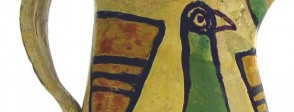Explore the Saintonge Jug, using the image in For the classroom. Move from ”What can we see?” to “What can we say?” and allow students to list “What should we ask?”; that is, make transitions from observation, through inference to interpretation, but with an awareness of what other sources or knowledge might help. Discuss material, shape, structure, decoration, signs of damage and repair; how it was made; where it was found, what it was for, the status of its owner. Add relevant contextual information as you wish but encourage sensible, supported inference for as long as possible. Finish by providing a summary of what archaeologists know about the jug, but link the summary to the students’ suggestions and questions to show the quality of their thinking.
You can use the jug to ask why pottery is so important for archaeologists. It is rarely found in one piece and is often only found in tiny fragments, but archaeologists find it invaluable. Why is this? How does it help them? Guide students to see that it is durable and survives, it can be identified and classified by type and age and it can reveal social status and lifestyle, levels of technology and the extent of trade links.
Ask the students to make a list of all the processes and all the people involved in the jug being made and finding its way to Lesnes Abbey near London. You may want to start this by asking what the jug is made from. The clay is particularly fine so the trail could start with someone searching for and then digging out and cleaning high quality clay in the Saintonge region. It ends with transportation to and use in an English abbey. Students may find it helpful to watch the English Heritage video of a potter and the image of a potter in a French manuscript that can be found in For the classroom.
Look at the five English jugs in A bigger picture. Discuss what themes associated with wine and ale consumption they relate to. Print out the images and supplement them with a range of other English and Saintonge jugs by searching the British Museum collection online for jugs from AD 1200 to 1400 or by doing an internet search. Tell students that museums are often asked to supply objects to feature in exhibitions that have a theme. You can then invent a list of relevant themes and invite students to say which of the jugs they would match with which theme. Alternatively, you could ask them to invent themes and titles for a range of themed exhibitions in which some of these jugs might feature.
These three questions show some different approaches to using the Saintonge Jug within broader enquiries.
Wine or wool? Which did more to shape medieval England?
Start with the Saintonge jug and one or more of the activities above to engage students in the study of medieval trade with Europe. The book excerpt under More information in About the object might act as a guide for your planning. Consider what these commodities reveal about the lives of those wealthy enough to enjoy them.
Consider the impact of wine imports on England’s own wine production. Consider how many groups in society and aspects of life were influenced by each commodity; for example the wool trade and the subsequent cloth trade shaped the landscape through the grazing of sheep on owners’ estates and created a wide range of occupations. You might discuss the growth of ports and the rise of wealthy merchants who often left signs of their wealth in local churches. The shift in the balance of trade away from south west France towards northern France and the Low Countries might take in the rise of piracy in the English Channel and the immigration of weavers from Flanders to England as the cloth trade grew. The English Heritage PDF file on a Southampton merchant’s house would be very helpful in this enquiry.
What do we make of myths about the medieval period?
The enquiry might take three or more popular views of medieval life and events and put them to the test. Use the Saintonge jug to develop the first myth: that everyone drank ale, beer or wine - this in turn can take in a study of health and living conditions. Other possibilities might be the supposedly universal belief that the world was flat and the notion that the early medieval period should be called the Dark Ages.
How did the English kings lose their French empire?
Use the Saintonge jug as the hook for leading students to understand how closely England and France were tied around AD 1300. Move on to consider the factors and events that meant that by 1453 the Hundred Years War had severed that connection.
Look at the bronze ewer in For the classroom. Compare it with the Saintonge jug. Use the link in About the object to provide information about the ewer as an object from medieval England. Reveal where it was found. Explore how it may have got to the court of the king of the Asante and discuss what light this may cast on contacts among cultures in this period. Then discuss how it came to end up back in England in the late AD 1800s.


